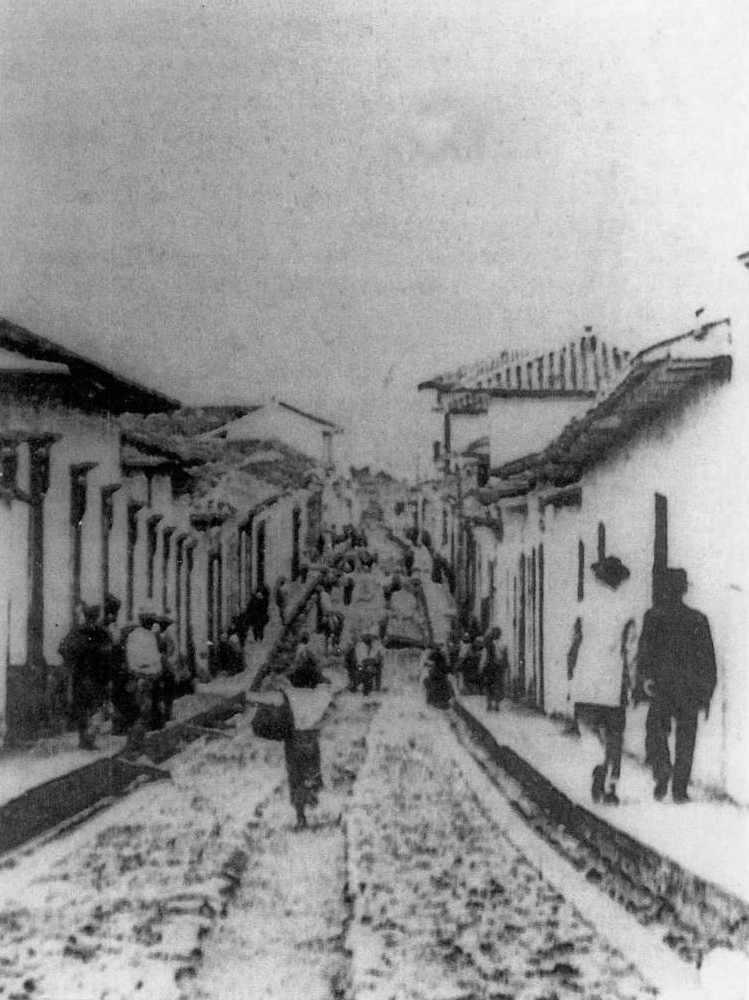|
Universidad Autónoma De Bucaramanga
The Universidad Autónoma de Bucaramanga or UNAB (Autonomous University of Bucaramanga) is a private post-secondary education institution in Bucaramanga, Colombia. It was founded in 1952 under the name of Instituto Caldas. In 1956 the institution was recognized as a law school, and became a university under the current name in 1987. Administration, Law and Public Accounting An accountant is a practitioner of accounting or accountancy. Accountants who have demonstrated competency through their professional associations' certification exams are certified to use titles such as Chartered Accountant, Chartered Certif ... are its oldest programs. It now offers 19 programs. References {{Authority control Universities and colleges established in 1952 1952 establishments in Colombia ... [...More Info...] [...Related Items...] OR: [Wikipedia] [Google] [Baidu] |
Private University
Private universities and private colleges are higher education institutions not operated, owned, or institutionally funded by governments. However, they often receive tax breaks, public student loans, and government grants. Depending on the country, private universities may be subject to government regulations. Private universities may be contrasted with public universities and national universities which are either operated, owned or institutionally funded by governments. Additionally, many private universities operate as nonprofit organizations. Across the world, different countries have different regulations regarding accreditation for private universities and as such, private universities are more common in some countries than in others. Some countries do not have any private universities at all. Africa Egypt Egypt currently has 21 public universities with about two million students and 23 private universities with 60,000 students. Egypt has many private universities in ... [...More Info...] [...Related Items...] OR: [Wikipedia] [Google] [Baidu] |
Bucaramanga
Bucaramanga () is the capital and largest city of the department of Santander Department, Santander, Colombia. Bucaramanga has the fifth-largest economy by GDP in Colombia, has the lowest unemployment rate and is the ninth most populous city in the country, with a population of 613,400 (2023 projection). Bucaramanga has over 160 parks scattered throughout the city and has been given the nickname "La Ciudad de Los Parques" ("The City of Parks") and "La Ciudad Bonita de Colombia" ("Colombia's Beautiful City"). Bucaramanga has grown rapidly since the 1960s, mostly into neighbouring locations within the metropolitan area. Floridablanca, Santander, Floridablanca, San Juan de Girón, Girón and Piedecuesta are inextricably linked geographically and commercially with Bucaramanga, and now all form together the Bucaramanga Metropolitan Area with a population of 1,304,288. The city is the base of the Colombian Petroleum Institute (ICP), the research branch of the state oil company Ecope ... [...More Info...] [...Related Items...] OR: [Wikipedia] [Google] [Baidu] |
Santander Department
Santander () is a department of Colombia. Santander inherited the name of one of the nine original states of the United States of Colombia. It is located in the central northern part of the country, borders the Magdalena River to the east, Boyacá to the south and southeast, the Norte de Santander Department to the northeast, the Cesar Department to the north, the Bolivar and Antioquia Departments to the west. Its capital is the city of Bucaramanga. History Pre-Columbian era Prior to the arrival of the Spaniards, the territory now known as Santander was inhabited by Amerindian ethnic groups: Muisca, Chitareros, Laches, Yariguí, Opón, Carare and Guanes. Their political and social structure was based on ''cacicazgos'', a federation of tribes led by a ''cacique'', with different social classes. Their main activity was planting maize, beans, yuca, arracacha, cotton, agave, tobacco, tomato, pineapple and guava, among others. Their agricultural skills were suffi ... [...More Info...] [...Related Items...] OR: [Wikipedia] [Google] [Baidu] |
Colombia
Colombia, officially the Republic of Colombia, is a country primarily located in South America with Insular region of Colombia, insular regions in North America. The Colombian mainland is bordered by the Caribbean Sea to the north, Venezuela to the east and northeast, Brazil to the southeast, Peru and Ecuador to the south and southwest, the Pacific Ocean to the west, and Panama to the northwest. Colombia is divided into 32 Departments of Colombia, departments. The Capital District of Bogotá is also the List of cities in Colombia by population, country's largest city hosting the main financial and cultural hub. Other major urban areas include Medellín, Cali, Barranquilla, Cartagena, Colombia, Cartagena, Santa Marta, Cúcuta, Ibagué, Villavicencio and Bucaramanga. It covers an area of 1,141,748 square kilometers (440,831 sq mi) and has a population of around 52 million. Its rich cultural heritage—including language, religion, cuisine, and art—reflects its history as a co ... [...More Info...] [...Related Items...] OR: [Wikipedia] [Google] [Baidu] |
Orange (colour)
Orange is the colour between yellow and red on the spectrum of visible light. The human eyes perceive orange when observing light with a dominant wavelength between roughly 585 and 620 nanometres. In traditional colour theory, it is a secondary colour of pigments, produced by mixing yellow and red. In the RGB colour model, it is a tertiary colour. It is named after the orange (fruit), fruit of the same name. The orange colour of many fruits and vegetables, such as carrots, pumpkins, sweet potatoes, and Orange (fruit), oranges, comes from carotenes, a type of photosynthetic pigment. These pigments convert the light energy that the plants absorb from the Sun into chemical energy for the plants' growth. Similarly, the hues of autumn leaves are from the same pigment after chlorophyll is removed. In Europe and the United States, surveys show that orange is the colour most associated with amusement, the unconventional, extroversion, warmth, fire, energy, activity, danger, taste and a ... [...More Info...] [...Related Items...] OR: [Wikipedia] [Google] [Baidu] |
White
White is the lightest color and is achromatic (having no chroma). It is the color of objects such as snow, chalk, and milk, and is the opposite of black. White objects fully (or almost fully) reflect and scatter all the visible wavelengths of light. White on television and computer screens is created by a mixture of red, blue, and green light. The color white can be given with white pigments, especially titanium dioxide. In ancient Egypt and ancient Rome, priestesses wore white as a symbol of purity, and Romans wore white togas as symbols of citizenship. In the Middle Ages and Renaissance a white unicorn symbolized chastity, and a white lamb sacrifice and purity. It was the royal color of the kings of France as well as the flag of monarchist France from 1815 to 1830, and of the monarchist movement that opposed the Bolsheviks during the Russian Civil War (1917–1922). Greek temples and Roman temples were faced with white marble, and beginning in the 18t ... [...More Info...] [...Related Items...] OR: [Wikipedia] [Google] [Baidu] |
Post-secondary
Tertiary education (higher education, or post-secondary education) is the educational level following the completion of secondary education. The World Bank defines tertiary education as including universities, colleges, and vocational schools. ''Higher education'' is taken to include undergraduate and postgraduate education, while vocational education beyond secondary education is known as ''further education'' in the United Kingdom, or included under the category of ''continuing education'' in the United States. Tertiary education generally culminates in the receipt of Academic certificate, certificates, diplomas, or academic degrees. Higher education represents levels 5, 6, 7, and 8 of the ISCED#2011 version, 2011 version of the International Standard Classification of Education structure. Tertiary education at a nondegree level is sometimes referred to as further education or continuing education as distinct from higher education. UNESCO stated that tertiary education focu ... [...More Info...] [...Related Items...] OR: [Wikipedia] [Google] [Baidu] |
Vanguardia (Colombian Newspaper)
''Vanguardia'' (), formerly ''Vanguardia Liberal'', is a Colombian regional newspaper, founded in September 1919 in Bucaramanga, Colombia, by Alejandro Galvis Galvis Alejandro Galvis Galvis (13 February 1891 – 17 June 1981) was a Colombian publisher and politician. He graduated the law school of the Universidad Republicana de Bogotá. From 1914 on he worked as journalist for the newspapers ''Juventud Libe ..., whose descendants are its current owners. It was formerly known as ''Vanguardia Liberal'', until it changed its name in March 2019 References Newspapers established in 1919 Spanish-language newspapers Newspapers published in Colombia Mass media in Bucaramanga {{DEFAULTSORT:Vanguardia ... [...More Info...] [...Related Items...] OR: [Wikipedia] [Google] [Baidu] |
Law School
A law school (also known as a law centre/center, college of law, or faculty of law) is an institution, professional school, or department of a college or university specializing in legal education, usually involved as part of a process for becoming a judge, lawyer, or other legal professional within a given jurisdiction. Depending on the country, legal system, or desired qualifications, the coursework is undertaken at undergraduate, graduate, or both levels. Law degrees Argentina In Argentina, lawyers-to-be need to obtain an undergraduate degree in law in order to practice the profession, as opposed to the US system in which a law degree is not obtained until successfully completing a postgraduate program. In spite of that, it is customary to call Argentine lawyers 'doctors,' although the vast majority of them do not hold a Juris Doctor degree. The reason lies in that the career was originally called 'Doctorate in Laws' (''Doctorado en Leyes''), which was an undergradua ... [...More Info...] [...Related Items...] OR: [Wikipedia] [Google] [Baidu] |
University
A university () is an educational institution, institution of tertiary education and research which awards academic degrees in several Discipline (academia), academic disciplines. ''University'' is derived from the Latin phrase , which roughly means "community of teachers and scholars". Universities typically offer both undergraduate education, undergraduate and postgraduate education, postgraduate programs. The first universities in Europe were established by Catholic Church, Catholic monks. The University of Bologna (), Italy, which was founded in 1088, is the first university in the sense of: *being a high degree-awarding institute. *using the word (which was coined at its foundation). *having independence from the ecclesiastic schools and issuing secular as well as non-secular degrees (with teaching conducted by both clergy and non-clergy): grammar, rhetoric, logic, theology, canon law and notarial law.Hunt Janin: "The university in medieval life, 1179–1499", McFarland, 2 ... [...More Info...] [...Related Items...] OR: [Wikipedia] [Google] [Baidu] |
Business Administration
Business administration is the administration of a commercial enterprise. It includes all aspects of overseeing and supervising the business operations of an organization. Overview The administration of a business includes the performance or management of business operations and decision-making, as well as the efficient organization of people and other resources to direct activities towards common goals. In general, "administration" refers to the broader management function, including the associated finance, personnel and MIS services. Administration can refer to the bureaucratic or operational performance of routine office tasks, usually internally oriented and reactive rather than proactive. Administrators, broadly speaking, engage in a common set of functions to meet an organization's goals. Henri Fayol (1841–1925) described these "functions" of the administrator as " the five elements of administration". According to Fayol, the five functions of management are pl ... [...More Info...] [...Related Items...] OR: [Wikipedia] [Google] [Baidu] |







